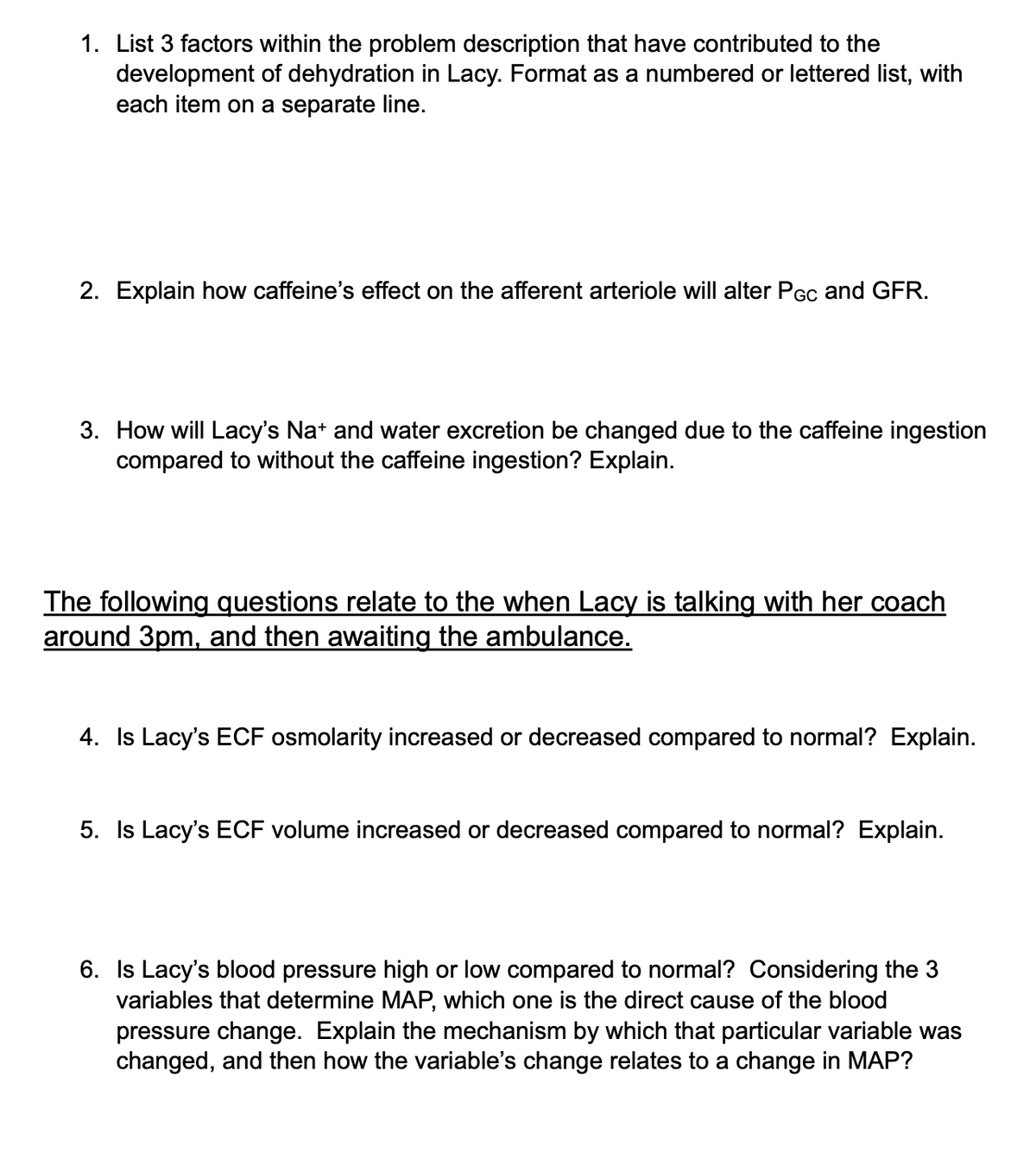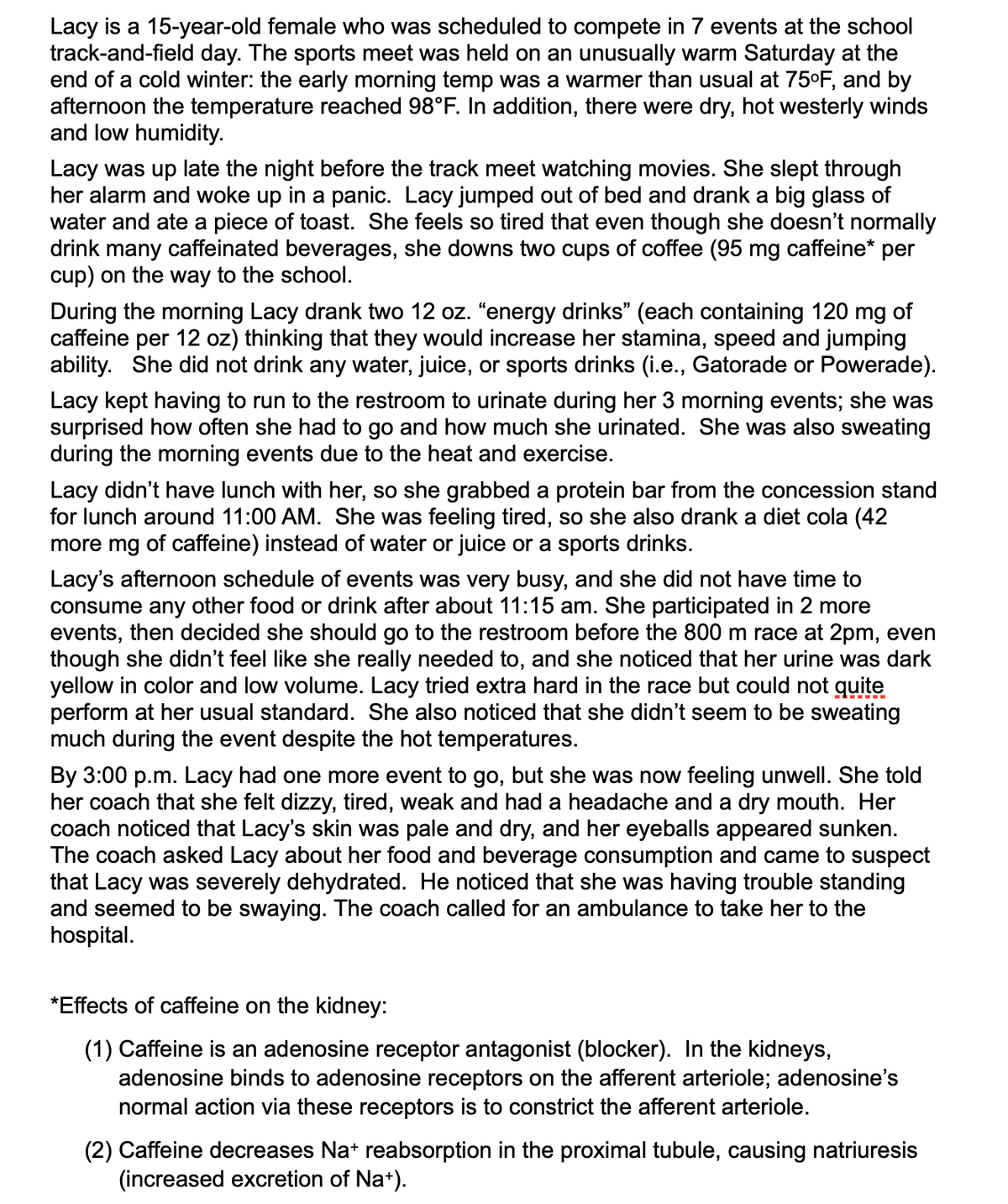4. Is Lacy's ECF osmolarity increased or decreased compared to normal? Explain. 5. Is Lacy's ECF volume increased or decreased compared to normal? Explain. 6. Is Lacy's blood pressure high or low compared to normal? Considering the 3 variables that determine MAP, which one is the direct cause of the blood pressure change. Explain the mechanism by which that particular variable was changed, and then how the variable's change relates to a change in MAP?
4. Is Lacy's ECF osmolarity increased or decreased compared to normal? Explain. 5. Is Lacy's ECF volume increased or decreased compared to normal? Explain. 6. Is Lacy's blood pressure high or low compared to normal? Considering the 3 variables that determine MAP, which one is the direct cause of the blood pressure change. Explain the mechanism by which that particular variable was changed, and then how the variable's change relates to a change in MAP?
Human Anatomy & Physiology (11th Edition)
11th Edition
ISBN:9780134580999
Author:Elaine N. Marieb, Katja N. Hoehn
Publisher:Elaine N. Marieb, Katja N. Hoehn
Chapter1: The Human Body: An Orientation
Section: Chapter Questions
Problem 1RQ: The correct sequence of levels forming the structural hierarchy is A. (a) organ, organ system,...
Related questions
Question
Read the prompt and answer subquestions 4, 5, and 6

Transcribed Image Text:1. List 3 factors within the problem description that have contributed to the
development of dehydration in Lacy. Format as a numbered or lettered list, with
each item on a separate line.
2. Explain how caffeine's effect on the afferent arteriole will alter PGc and GFR.
3. How will Lacy's Na* and water excretion be changed due to the caffeine ingestion
compared to without the caffeine ingestion? Explain.
The following questions relate to the when Lacy is talking with her coach
around 3pm, and then awaiting the ambulance.
4. Is Lacy's ECF osmolarity increased or decreased compared to normal? Explain.
5. Is Lacy's ECF volume increased or decreased compared to normal? Explain.
6. Is Lacy's blood pressure high or low compared to normal? Considering the 3
variables that determine MAP, which one is the direct cause of the blood
pressure change. Explain the mechanism by which that particular variable was
changed, and then how the variable's change relates to a change in MAP?

Transcribed Image Text:Lacy is a 15-year-old female who was scheduled to compete in 7 events at the school
track-and-field day. The sports meet was held on an unusually warm Saturday at the
end of a cold winter: the early morning temp was a warmer than usual at 75°F, and by
afternoon the temperature reached 98°F. In addition, there were dry, hot westerly winds
and low humidity.
Lacy was up late the night before the track meet watching movies. She slept through
her alarm and woke up in a panic. Lacy jumped out of bed and drank a big glass of
water and ate a piece of toast. She feels so tired that even though she doesn't normally
drink many caffeinated beverages, she downs two cups of coffee (95 mg caffeine* per
cup) on the way to the school.
During the morning Lacy drank two 12 oz. "energy drinks" (each containing 120 mg of
caffeine per 12 oz) thinking that they would increase her stamina, speed and jumping
ability. She did not drink any water, juice, or sports drinks (i.e., Gatorade or Powerade).
Lacy kept having to run to the restroom to urinate during her 3 morning events; she was
surprised how often she had to go and how much she urinated. She was also sweating
during the morning events due to the heat and exercise.
Lacy didn't have lunch with her, so she grabbed a protein bar from the concession stand
for lunch around 11:00 AM. She was feeling tired, so she also drank a diet cola (42
more mg of caffeine) instead of water or juice or a sports drinks.
Lacy's afternoon schedule of events was very busy, and she did not have time to
consume any other food or drink after about 11:15 am. She participated in 2 more
events, then decided she should go to the restroom before the 800 m race at 2pm, even
though she didn't feel like she really needed to, and she noticed that her urine was dark
yellow in color and low volume. Lacy tried extra hard in the race but could not guite
perform at her usual standard. She also noticed that she didn't seem to be sweating
much during the event despite the hot temperatures.
By 3:00 p.m. Lacy had one more event to go, but she was now feeling unwell. She told
her coach that she felt dizzy, tired, weak and had a headache and a dry mouth. Her
coach noticed that Lacy's skin was pale and dry, and her eyeballs appeared sunken.
The coach asked Lacy about her food and beverage consumption and came to suspect
that Lacy was severely dehydrated. He noticed that she was having trouble standing
and seemed to be swaying. The coach called for an ambulance to take her to the
hospital.
*Effects of caffeine on the kidney:
(1) Caffeine is an adenosine receptor antagonist (blocker). In the kidneys,
adenosine binds to adenosine receptors on the afferent arteriole; adenosine's
normal action via these receptors is to constrict the afferent arteriole.
(2) Caffeine decreases Na* reabsorption in the proximal tubule, causing natriuresis
(increased excretion of Na+).
Expert Solution
This question has been solved!
Explore an expertly crafted, step-by-step solution for a thorough understanding of key concepts.
This is a popular solution!
Trending now
This is a popular solution!
Step by step
Solved in 4 steps

Recommended textbooks for you

Human Anatomy & Physiology (11th Edition)
Anatomy and Physiology
ISBN:
9780134580999
Author:
Elaine N. Marieb, Katja N. Hoehn
Publisher:
PEARSON

Anatomy & Physiology
Anatomy and Physiology
ISBN:
9781259398629
Author:
McKinley, Michael P., O'loughlin, Valerie Dean, Bidle, Theresa Stouter
Publisher:
Mcgraw Hill Education,

Human Anatomy
Anatomy and Physiology
ISBN:
9780135168059
Author:
Marieb, Elaine Nicpon, Brady, Patricia, Mallatt, Jon
Publisher:
Pearson Education, Inc.,

Human Anatomy & Physiology (11th Edition)
Anatomy and Physiology
ISBN:
9780134580999
Author:
Elaine N. Marieb, Katja N. Hoehn
Publisher:
PEARSON

Anatomy & Physiology
Anatomy and Physiology
ISBN:
9781259398629
Author:
McKinley, Michael P., O'loughlin, Valerie Dean, Bidle, Theresa Stouter
Publisher:
Mcgraw Hill Education,

Human Anatomy
Anatomy and Physiology
ISBN:
9780135168059
Author:
Marieb, Elaine Nicpon, Brady, Patricia, Mallatt, Jon
Publisher:
Pearson Education, Inc.,

Anatomy & Physiology: An Integrative Approach
Anatomy and Physiology
ISBN:
9780078024283
Author:
Michael McKinley Dr., Valerie O'Loughlin, Theresa Bidle
Publisher:
McGraw-Hill Education

Human Anatomy & Physiology (Marieb, Human Anatomy…
Anatomy and Physiology
ISBN:
9780321927040
Author:
Elaine N. Marieb, Katja Hoehn
Publisher:
PEARSON